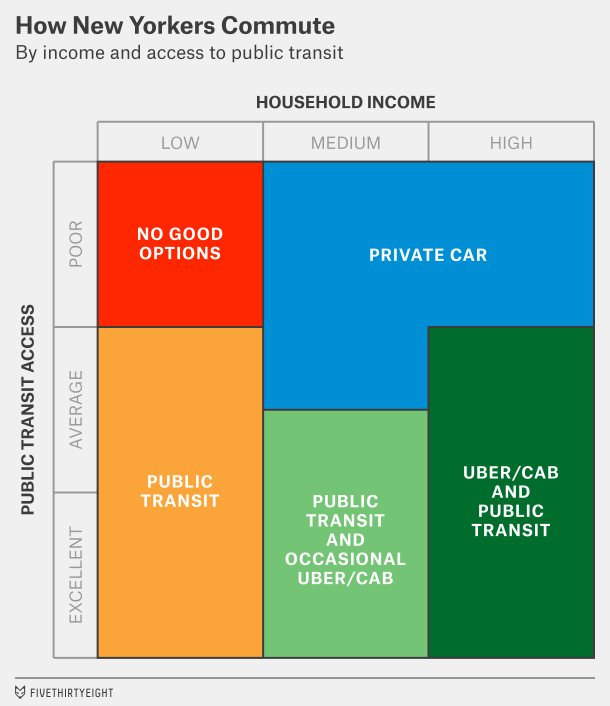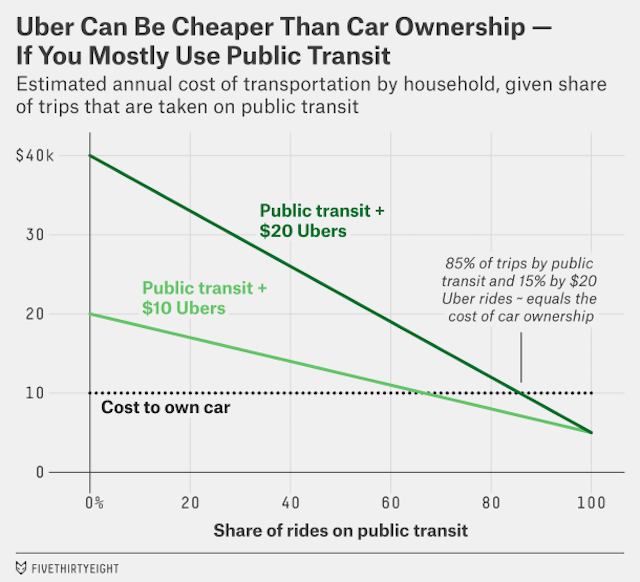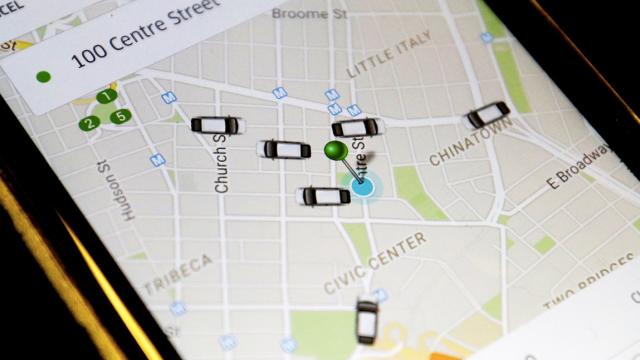Uber’s destruction of the taxi industry is obvious — and NYC cabs are finally fighting back. But how much of a threat is Uber to other modes of transportation? Earlier this week I worried that Uber’s plan to more easily scoop people off city streets might take ridership away from public transit. But a FiveThirtyEight investigation claims that might not be the case.
A team at FiveThirtyEight used Census data and Uber ridership information gathered from an FOIA request to examine how people in New York City were using personal cars, cabs, public transit, and Uber to get around. They divided New York’s population into five groups based on income and accessibility to transit, as you can see in this chart:

Some New Yorkers rely on public transit exclusively, no surprise. Others have poor access to subways and have to own a car at great expense — and they can’t afford Uber. You’d think that car ownership would increase with income, but the highest income neighbourhoods (in NYC at least) actually have the best transit access, so many of these people don’t require a car. They can most easily get by with a Uber/cab/transit mix.
So here’s the key insight: Those with great access to transit still used it much or most of the time, no matter their income. Uber was always supplementary.
The argument only holds for New York City, which is slightly problematic: I argued in my earlier piece that NYC is actually not the norm because it has such a well-established, high-ridership transit system; it’s often more convenient than Uber. But when you look at the data this way, it might be the best possible city to look at because New York offers the largest, most diverse sampling of people riding public transit in the US. You can actually see what happens when people have choices — and in most cases they never turn their backs completely on transit. It’s always a mix.
Let’s take this logic to another city where transit isn’t as universal. Very few of us can afford to take Uber exclusively (or Lyft, or cabs, or whatever) but when used in combination with public transit, suddenly Uber makes longer trips (like commutes) more affordable. This is exactly the first mile-last mile solution brought to life by Tampa’s HART transit system, which is partnering with Uber and Lyft to help make it easier to get people to and from transit stops. Uber might actually be helping get more riders onto their buses.
So can Uber really help you ditch your car for good?
Finally, and maybe most importantly, FiveThirtyEight also addressed the claim many people are making that exclusively Ubering can replace their personal car. A lot of it is measuring what your own personal time is worth, of course, but it turns out that it makes financial sense — if you use public transit most of the time. Here’s the sweet spot for when the public transit + Uber combo becomes more affordable than car ownership (for NYC, at least):

This chart put everything in perspective to me, as a conflicted user of on-demand ride services. If I can still take public transit 85% of the time, that means a majority of my ridership (and money) are still going to transit, and I can still use the occasional Lyft or taxi, and it’s all a better deal than having a car.
I was and still am worried that cheaper and cheaper Ubers will eventually steal riders away from public transit, meaning that the transportation infrastructure and improvements that most cities in the US need won’t get properly funded. But maybe enough people can do these calculations for themselves now which means we can take more personal cars off the road permanently — which would provide many more benefits to a city’s residents including alleviating congestion, improving air quality, and reducing the need for so much land to be devoted to parking.
Uber is still cars on the road — one brilliant comment to my piece said Uber is like “outsourcing your driving” — but there’s a big difference when you’ve already shed your own vehicle and are simply using Uber to get a ride to the train station. In certain cities, for certain people, Uber might actually help make transit more accessible.
